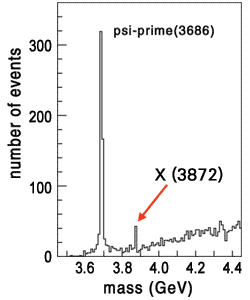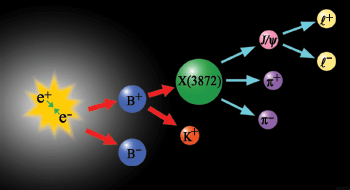|
An international team of researchers at the High Energy Accelerator Research organization (KEK) in Tsukuba recently announced the discovery of a new and unusual sub-atomic particle. This particle, which the researchers are calling the X(3872), weighs about the same as a single atom of helium and exists for only about one billionth of a trillionth of a second before it decays to other longer-lived, more familiar particles. Although extremely short-lived by any human standard, this is nearly an eternity for a sub-atomic particle this heavy.
The new particle was found among the decay products of so-called beauty mesons that are produced in large numbers at the KEKB "B-factory," an electron-positron collider at the KEK laboratory that is specialized for producing large numbers of particles that contain a b ("beauty") quark. There the "Belle collaboration," an international team of faculty and student researchers from Universities and laboratories from eleven different countries, operate of the Belle detector, which is tailored to study the particles produced at KEKB. Belle is a complex assortment of highly sensitive radiation detectors located inside of a large superconducting electromagnet, The device took nearly ten years to design and build.
While investigating various ways the B-mesons (particles that contain a b quark) decay, the Belle team observed that they can decay into X(3872) and K-meson although its occurrence is extremely rare. The X(3872) almost instantly decays into a ``J-psi'' particle and two pi-mesons. (Figures)
There are hundreds of sub-atomic particles and the discovery of a new one is usually not an extraordinary event. However, as its name implies, the X(3872) particle is peculiar in that it does not easily fit into any known particle scheme and, as a result, has attracted a considerable amount of attention from the world's physics community. The Belle discovery was recently confirmed by researchers with the CDF experiment at the Fermi National Accelerator Laboratory in Illinois, home of the Tevatron, the world's largest atom smasher. There the X(3872) is referred to as the "mystery meson."
A normal "meson" particle is comprised of a quark and an antiquark that are held together by the "color" force, also called as "strong" force because it is the most powerful force in nature. The large variety of meson particles that have been found to date reflect the many different ways that these combinations can be accomplished. However, the mass and the decay properties of the X(3872) do not match theoretical expectations for any conceivable quark-antiquark arrangement.
Theoretical physicists around the world are considering a number of potential explanations. These include modifications to the theory of the color force, or the possibility that the X(3872) is the first example to be seen of a new type of meson, one that is made from four quarks (i.e. two quarks and two antiquarks).
The discovery is described in a report published in this week's edition of Physical Review Letters, a prestigious journal for physics research.
|




